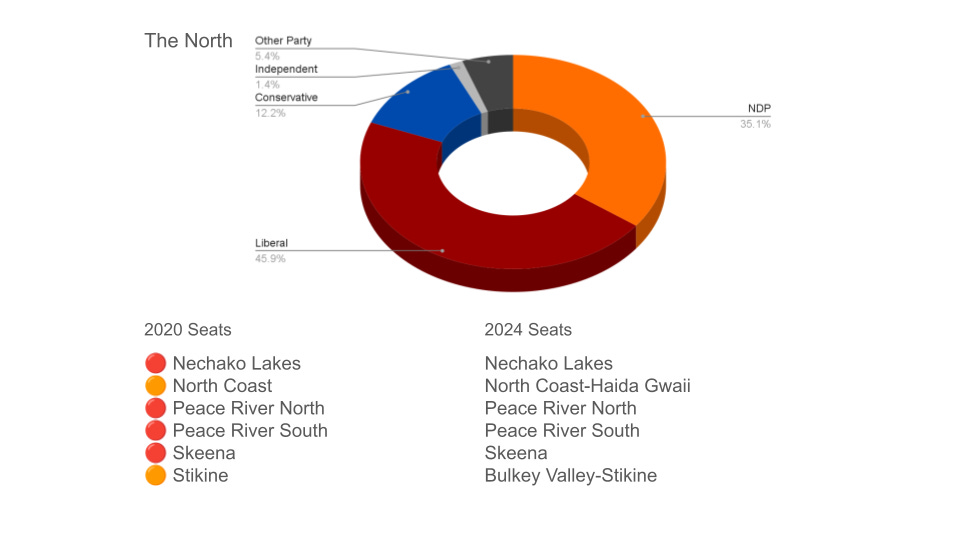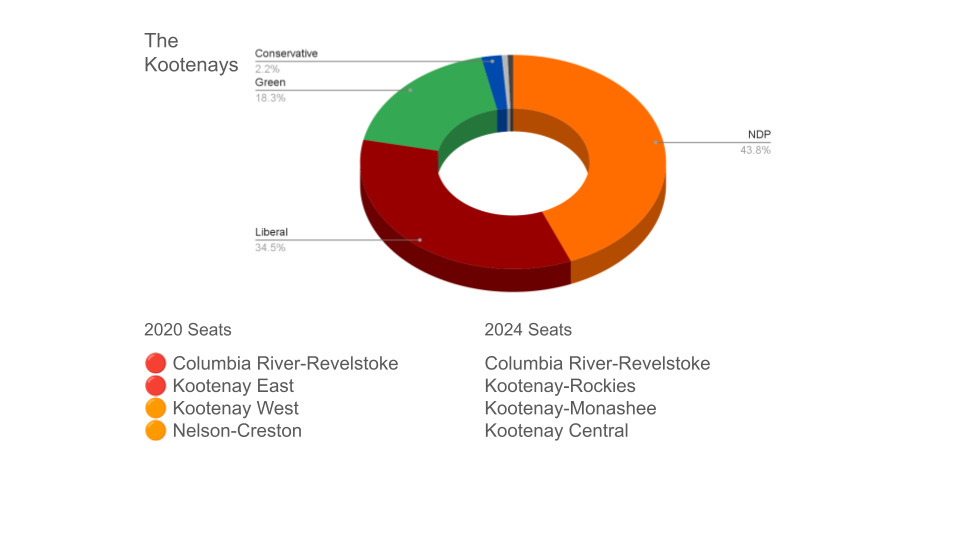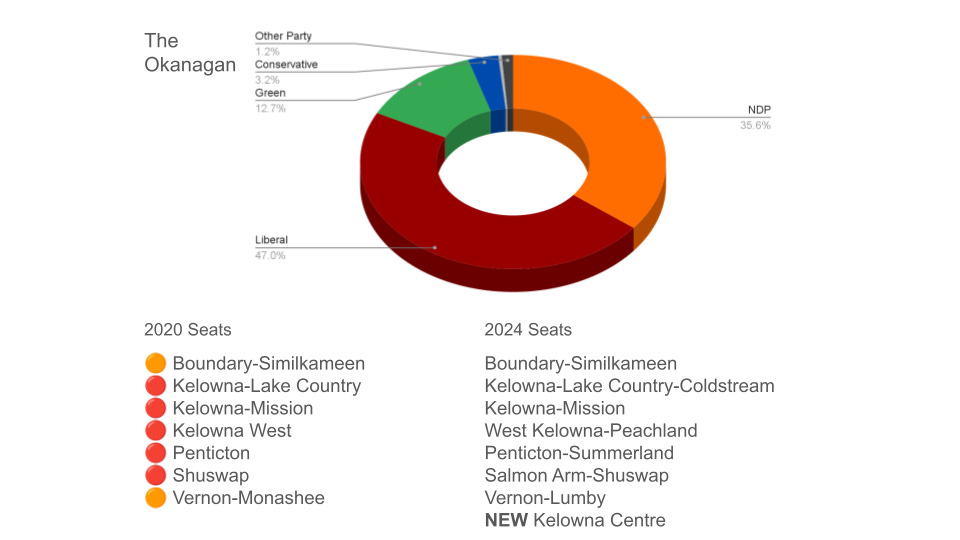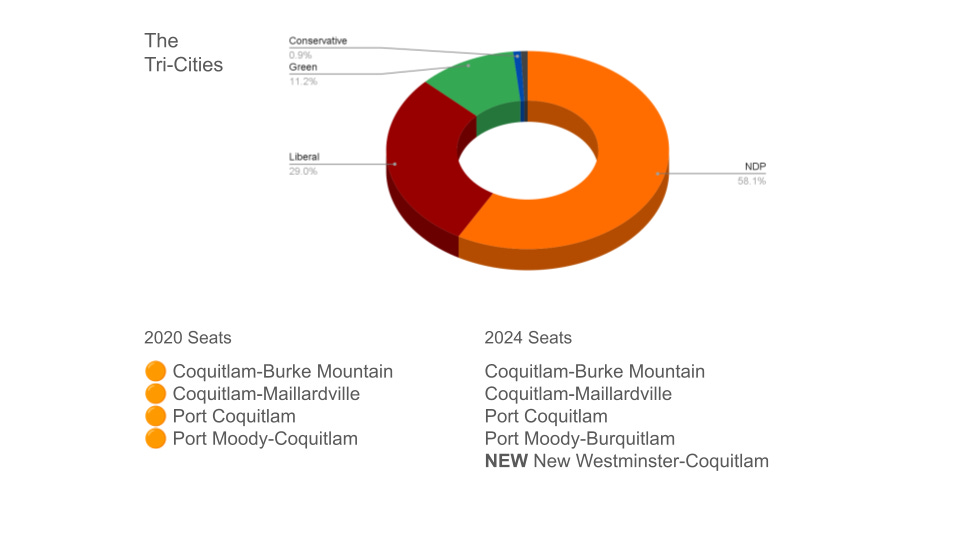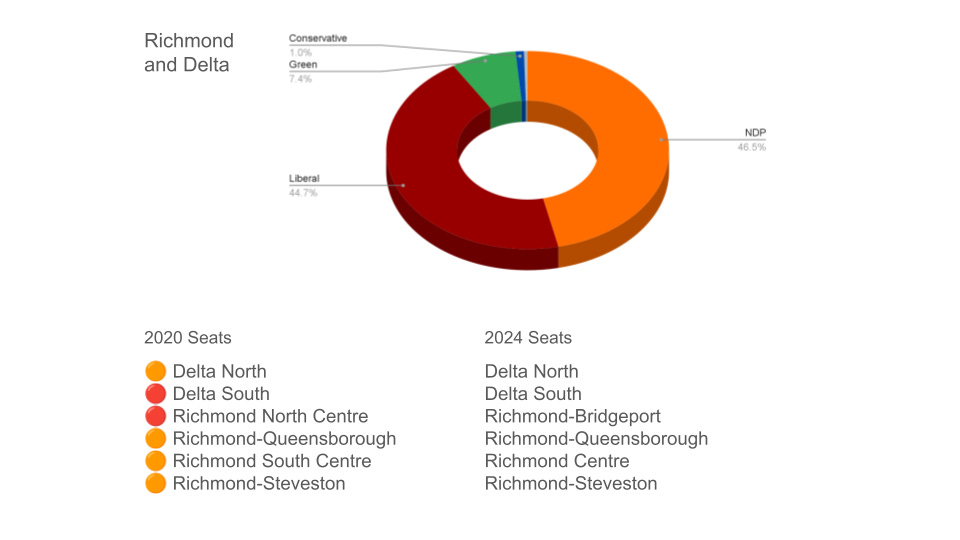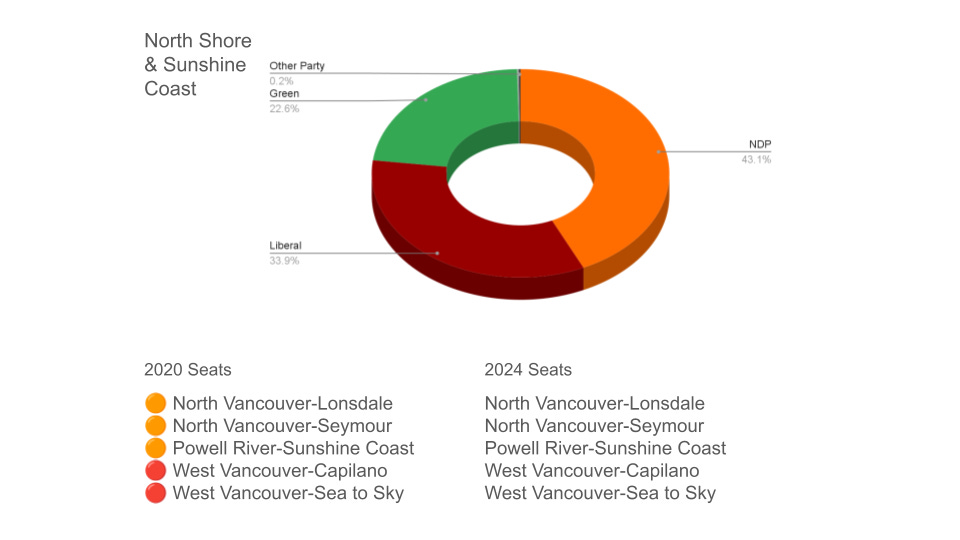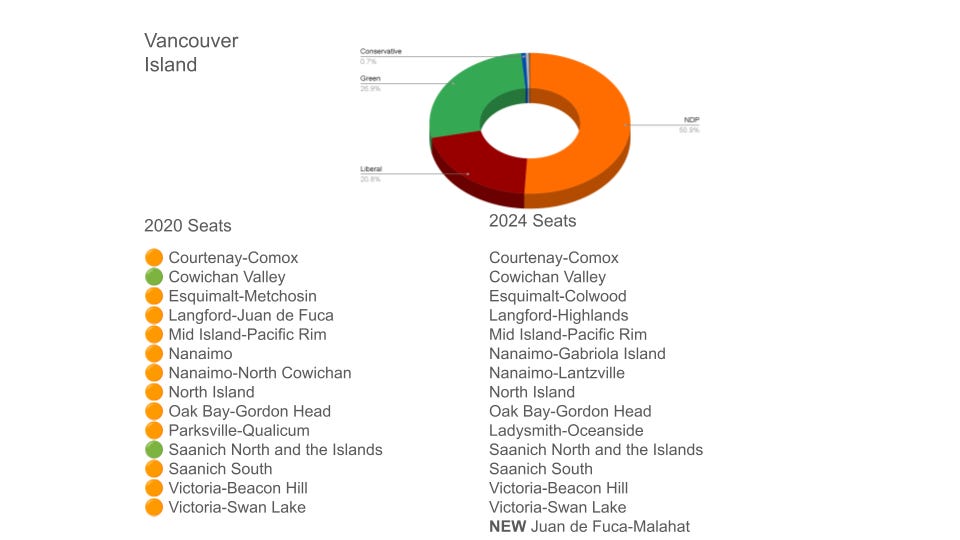There is not one election on October 19th. Each riding holds its own vote for their representative, which means technically 93 elections will be taking place at the same time. That is why when polls show the NDP and Conservatives “neck-and-neck” that does not necessarily mean that the parties have an equal chance of winning the most seats. A party may be polling high province-wide because they are strong in a particular region, but have no chance at winning seats elsewhere.
This happens federally as well. The Bloc Québécois runs only in Quebec, which means that while they received only 7.6% of the popular vote in the last election, they elected 32 representatives, while the NDP elected 25 Members of Parliament with 17.8% support Canada-wide.
British Columbia, being the size of France, Germany and the Netherlands combined, has a diverse population with different voting patterns across the province. Today, I’m going to look at how those regions voted in the last election, and what that might mean for the coming one.
Since the last election the Electoral Boundaries Commission has redrawn the map, bringing the seat count from 87 to 93, and shifting many ridings to account for population changes and shifts.
The North
British Columbia’s North has the largest and most sparsely populated ridings. Peace River North, for example, covers 160,485km² with a population of 32,353.
The North is divided politically between the ocean coast, which trends towards voting NDP, and the Peace River Region, where conservative parties dominate. Conservative leader John Rustad’s seat is Nechako Lakes.
The most notable ridings to watch in the North are Peace River North and Peace River South, where former BC Liberal MLAs Dan Davies and Mike Bernier are running for re-election as independents. Davies beat the previous BC Conservative leader Trevor Bolin in 2020 with 55.8% support, and Bernier won 51.2% to the Conservatives’ 30.5%.
Prince George, Cariboo & Thompson
Central British Columbia is, like the North, vast, beautiful and sparsely populated other than the urban centres of Prince George and Kamloops and a mix of smaller towns through the area. The drive between Kamloops and Prince George is very beautiful. I recommend stopping in William’s Lake.
A few ridings have changed names with some boundary realignments since 2020. Cariboo North is now Prince George-North Cariboo, and Kamloops-South Thompson is now Kamloops Centre.
It's expected (but you never know) the Conservatives will take all three Prince George ridings, and it is likely floor-crosser Lorne Doerkson will be re-elected in Cariboo-Chilcotin.
One riding to watch here is Kamloops Centre, where United-turned-Conservative Peter Milobar is running. Based on the redistribution, it was a statistical tie in 2020 between the BC Liberals and the NDP. The other is Prince George-North Cariboo, now that former BC Liberal MLA Coralee Oakes has thrown her hat in the ring as an independent.
Kootenays
The Kootenays is an incredibly majestic part of the province, with towering mountains and deep valleys, beautiful lakes and picturesque communities.
The Kootenays, like the North, tend to be divided politically between the East and West. Kootenay-Rockies (formerly Kootenay East) tends to vote for the conservative option, Columbia River-Revelstoke swings between the NDP and right-wing party, while Kootenay-Monashee (formerly Kootenay West) and Kootenay Central (formerly Nelson-Creston) generally vote NDP, with the Greens in second place in recent elections.
With Tom Shypitka running for re-election in Kootenay-Rockies as an independent after United’s collapse, it is a riding to watch. The other is Kootenay Central, where the Greens came a strong second in 2020 and have a chance of taking the seat if the NDP fare poorly.
Okanagan
The Okanagan — where I grew up! — spans from the US border all the way up to the Shuswap Lake, with beautiful, lush valleys and lakes in between. The Okanagan is particularly well known for its fruit orchards and wineries, as well as some excellent ski hills.
The Okanagan has generally been reliably conservative, with the BC Liberals holding dominance for the last two decades and the Social Credit Party before them. The redistribution added one new seat to this region in downtown Kelowna.
The new Kelowna Centre is a riding to watch, with the NDP targeting the seat with a popular city councillor running. It will also be worthwhile to keep an eye on Vernon-Lumby to see if the NDP can hold the seat, especially with Lumby mayor Kevin Acton running as an independent after United's implosion.
Boundary-Similkameen is always an interesting swing riding, but people don't talk about that because it's hard to pronounce Similkameen.
Fraser Valley
Colloquial wisdom is that the Fraser Valley is a conservative part of the province, but it swung to the NDP in 2020. A big question of the 2024 election will be whether they can hold on to their seats in Chilliwack, Langley and Maple Ridge.
The region has seen quite a bit of growth over the last decade, leading to a few changes in the redistribution since 2020. Langley gained a new seat with Langley-Abbotsford, where former Liberal MP John Aldag will face the BC Conservatives’ vice president Harman Bhangu. Langley East is now Langley-Walnut Grove, and Langley is now Langley-Willowbrook — the NDP hope to hold both ridings, making them ridings to watch on October 19th.
If the NDP can hold their seats in this region, they will likely be able to hold on to their majority government. If the BC Conservatives want to win, they will need to flip the Fraser. I would consider this area one of the main battlegrounds for 2024.
Tri-Cities
The Tri-Cities of Coquitlam, Port Coquitlam, and Port Moody is a fairly strong area for the NDP, with the exception of Coquitlam-Burke Mountain, which tends to swing back and forth.
The biggest change in the redistribution here is redrawing New Westminster to include parts of Coquitlam to become New Westminster-Coquitlam, and Burnaby-New Westminster, which I’ve included in the Burnaby section later on. With NDP incumbents running in three ridings, odds are the NDP will be able to hold all five seats.
The seat to watch here will be Coquitlam-Burke Mountain, where former MLA Jodie Wickens is jumping back into the fray after being narrowly defeated in 2017 by a mere 87 votes.
Richmond & Delta
Like the Fraser Valley, Richmond has tended to lean conservative in past elections. The weakened BC Liberal Party lost enough ground for the NDP to take three of the four Richmond ridings in 2020, which means they are targets for the Conservatives this time. With Teresa Wat and Ian Paton running in Richmond-Bridgeport (formerly Richmond Centre) and Delta South, the focus in this region will likely be the three other Richmond ridings.
Housing Minister Ravi Kahlon will very likely be re-elected in Delta North, especially with the BC United candidate appearing to endorse him, then (kinda) retracting it but still saying nice things about Kahlon.
Surrey
For the last three elections, Surrey has been repeatedly termed “battleground Surrey”. With densely populated swing ridings, it is very difficult to find a path to forming government without winning seats in Surrey.
Historically, the north-western parts of the city swing to the NDP, while the south and eastern parts, including White Rock and Cloverdale, go to the right. The NDP have an advantage with several incumbents running again, while the Conservatives benefit from both incumbent BC Liberals crossing the floor to run with them.
The biggest riding to watch here is Surrey-Cloverdale, a swing riding that has an NDP incumbent running against one of the early MLAs to leave BC United. Surrey has one new riding — Surrey-Serpentine River, where former mayor Linda Hepner is running for the BC Conservatives.
Burnaby and New Westminster
The NDP dominance in Burnaby has been in place for almost a decade, with the party even having an official municipal branch that holds city council. It is also where federal NDP leader Jagmeet Singh has his seat.
Burnaby saw some boundary changes in the redistribution. Burnaby-Deer Lake is now Burnaby Centre, Lougheed is now East, Edmonds is now Burnaby-New Westminster, and a new riding of Burnaby South-Metrotown has been added.
There is no real specific riding to watch in Burnaby, as they all had similar results in 2020. Short of an NDP collapse á la 2001 they will likely hold all five seats. An upset in Burnaby would be an election night surprise.
Vancouver
Vancouver often gets the most attention in elections, since it is one of the biggest hubs in the province and where much of the provincial media is located. Premier Eby and the NDP hold all but two of the 11 current seats, including his own of Vancouver-Point Grey.
One new riding has been added with several changes to other ridings to create the new one. Its primary contenders are two candidates from Vancouver’s recently-imploded conservative civic party, the NPA. The new riding, Vancouver-Yaletown, has former police officer and NPA board director, Terry Yung, facing off against recently defeated NPA city councillor Melissa de Genova. Yung is running for the NDP, and de Genova with the Conservatives.
For the most part the ridings to watch are the two that United held — Langara and Quilchena. The BC Liberals had been trending down across Vancouver for a couple elections, and if that trend holds Langara could flip NDP. Quilchena is less likely, but elections can be surprising.
One other to keep an eye on is Vancouver-Little Mountain, where current city councillor Christine Boyle is representing the NDP against former Park Commissioner John Coupar. Not because the NDP is likely to lose, but because drama just follows Coupar wherever he goes.
North Shore & Sunshine Coast
Vancouver's North Shore is where some of the wealthiest residents of BC live. It's also one of the rainiest parts of the province.
For decades the area voted to the right, but the NDP have been able to break in with North Vancouver-Lonsdale in 2017 and North Vancouver-Seymour in 2020. The Conservatives will be aiming to keep the seats won by the BC Liberals last time.
North Vancouver-Seymour is a riding to watch, where the close margins last time mean tougher odds for the NDP’s Susie Chant. The other to keep an eye on is West Vancouver-Sea to Sky, where the Greens appeared to win on election night in 2020, but lost it by a mere 60 votes after the mail-in ballots were counted.
Vancouver Island
Vancouver Island is a 32,100 km² island where the provincial capital and government are, as well as some of the best conditions for caving in North America. It’s also, like most of the rest of the province, stunning to look at.
The Island is dominated by the NDP, with their main challenger in many ridings being the distant Greens. The BC Liberals have historically done well in the northern parts of the Island, and Courtenay-Comox was the deciding seat in the 2017 election.
The redistribution added a new seat to Langford, as its population has been steadily growing as the rest of the capital region becomes impossibly expensive to live in. Nanaimo also gains a seat — with significant changes to its other two’s boundaries — Nanaimo-Lantzville.
For the Conservatives, the riding most likely to swing their way is Ladysmith-Oceanside, which had been a target for the Liberals when it was Parksville-Qualicum. The NDP’s Adam Walker was ejected from their caucus for unclear reasons, and is running as an independent there.
Other ridings to watch are both targets for the Greens. First, is Saanich North and the Islands, where Green MLA Adam Olsen has stepped down, leading to a messy nomination race. The other is where Green Party leader Sonia Furstenau flipped ridings twice and settled on running — Victoria-Beacon Hill — a riding that almost survived the NDP collapse of 2001.
The dark horse riding is Esquimalt-Colwood, where NDP MLA Mitzi Dean needed to step down only a few weeks ago, following BC United’s candidate stepping down rather than run with the BC Conservatives, leaving the Greens’ Camille Currie as the only candidate campaigning. She recently received the endorsement of the former BC United candidate, further adding to her chances.
Conclusion
For the most part, I think the battle for government this election is going to be concentrated in the Fraser Valley, Langley, and Maple Ridge, with seats elsewhere determining just how important those regions will be. The number of high profile independents — largely from United’s implosion — means one or more could get elected, which will make several individual races fun to watch on election night.
Of course, with 33 days to go, that is plenty of time for things to change.


